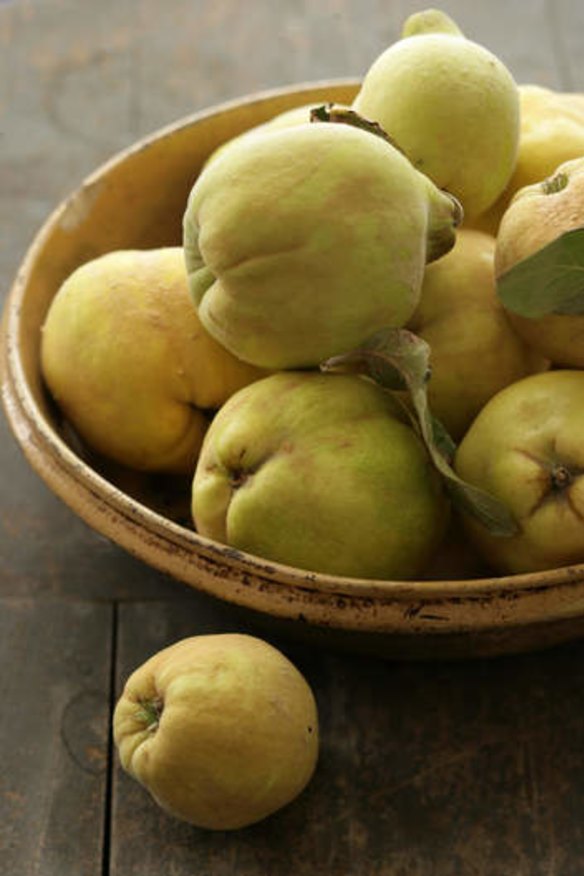Cooking with quince

Any suggestions on how to use quinces, other than in jam and paste? K. Barlow
Watch a quince blossom and you will understand the allure. Four soft petals, as pink as a Norman Lindsay nude, gently unfurl. With their hairy stamen they are almost indistinguishable from an old-fashioned rose. A member of the same family, along with apples and pears, their domestication is thought to predate these more popular fruit. Hard and bitter, a quince's true beauty is brought to bear through slow cooking. On a cold morning, turn the oven on to low and place a few or more unpeeled quinces on a tray and slowly roast them for several hours or until they are soft to touch. The starch turns to sugar, leaving the flesh sweet and rosy-pink and the kitchen filled with a rose-like aroma. The flesh can now be scooped out to top yoghurt for breakfast or roughly folded through a cake batter to create sweet streaks. Peel, core, quarter and slice quinces and slowly cook in a 50/50 sugar water syrup to create little candied quince rubies to decorate cakes and muffins or fold through fruit cake batters. Slow cook slices with lamb and spices in a tagine or with a whole chicken with dry sherry.
Recipes:
- Stephanie Alexander's poussin with quince and myrtle
- Brigitte Hafner's lamb with cinnamon, cardamom and quince
- Jane and Jeremy Strode's poached quince with spices
- Justin North's quince pudding with creme fraiche
- Caroline Velik's quince and apple crumble
- For more quince recipes visit the COOK section of Good Food
What sort of baking trays and tins should I buy to bake fabulous biscuits and cakes? I am a mum to two and just getting the baking bug. A. Macleod
There is nothing more rewarding than feeding the family your own baked goods. Although there are many variables in baking that will determine the outcome of your cakes, an investment in quality bakeware will help you produce consistently good results. Firstly, do not buy bakeware from the supermarket. It is cheap for a reason. Today's cheap cake tin is tomorrow's outside dog bowl. Head to a good food store or bakeware specialist. A heavy-based aluminium baking tray with upfolded lips on three sides not only cooks the bottoms of the biscuits evenly but also allows them to slide off the end of the tray once done. Match the size of your cake tins to the sizes of the cake tins called for in any recipe books you may have. Generally, cake tins in most cake books are about 20 centimetres to 23 centimetres and round. Add to the list a heavy-duty cake rack. Cheap ones buckle quickly and will affect the shape of the cake. An uneven cake is harder to ice. Buy a roll of good quality baking paper and you're set. Wash bakeware well and dry in the oven as it cools.
I am constantly frustrated by recipes in which sticky and viscous ingredients, such as honey, are measured in grams. How do you weigh 30 grams of honey and then get it into the mixture? L. Sterling
In baking, particularly, correct weights and measures are essential and some recipe writers prefer to give the exact measurement as opposed to one where there is a margin of error. So, when you get to the point where you need to add the 30 grams of honey, and you have a set of digital scales (which I highly recommend), place the bowl on the scales, tare them - reset to zero - and slowly drizzle in the honey. Honey is heavier than water, a 250-millilitre cup weighs 320 grams and a tablespoon weighs roughly 30 grams.
Why are restaurant meals still so expensive when the chef forages, finds and gleans the ingredients? B. Wagon
I trust you are asking a genuine question and not trying to make a point. Food costs in the total expenditure of most profitable restaurants are below 30 per cent. The rest is spent on wages, rent, electricity, gas, laundry, etc. The foraged component of a restaurant meal could be as little as a 20th of the dish. Foraged wild ingredients, such as samphire, fungus and cardoons, tend not to grow right next to a restaurant - hence the wild bit - so chefs have to spend time hunting them. Wild ingredients also require skilled staff to transform them into tasty morsels. Professional foragers rose with the advent of restaurants in 18th century France bringing wild produce into city kitchens and continue to do so. They don't provide their goods free of charge.
Got a question for Richard Cornish? Leave it in the comments below. Or email questions to: brainfood@richardcornish.com.au
The best recipes from Australia's leading chefs straight to your inbox.
Sign up- More:
- Brain food
